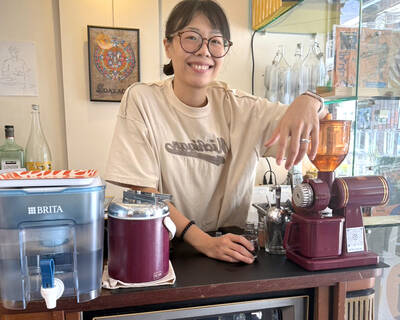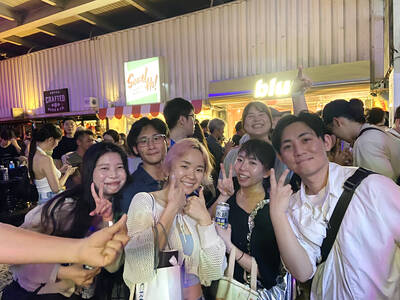Dancer/choreographer Sun Chuo-tai (孫梲泰) decided to call his company 8213 Physical Dance Theater (8213肢體舞蹈劇場) because he wanted the name to convey the idea that the company and its productions would be about more than “just dance.”
He wanted to break the mold, blur the boundaries between the dancers and the audience, between dance and theater, between movement and text — as well as examine the connections between them.
Connections, or rather the growing lack of them, are a common theme in Sun’s work. He examines them once again in the company’s newest production, Electron (電子), which began a four-day run at the Guling Street Theater (牯嶺街小劇場) last night.
“Electron ... We wanted to bring down the size of electricity, wanted to give a feeling to the topic, so we chose loneliness,” Sun said on Monday during an interview at the theater. “In society we have a lot of gadgets now, we don’t need to talk to one another. We’re a little more removed today.”
He said he wanted to examine what the proliferation of technology in our everyday life is doing to us.
“Last year my house lost electricity for one week. I thought ‘Oh, my God,’ it’s not convenient. Just to do your normal life — if you want to go to the bathroom, there is no light. I’m also a businessman; I need a cellphone, a laptop, a lot of electronics,” Sun said. “If you forget your cellphone, you panic. These things control your life.”
“We use these things to create a distance. We are connected but you don’t need to see one another. There are ‘no feelings,’ people even break-up by electronic devices. So finally we are at a great distance [from each other]. You close yourself off or use iPods to disconnect,” he said.
The company has been rehearsing the piece for four months, although the project has been in the works for a year. It’s a smaller production than last year’s Boundless: My Bliss (無國界—我的天堂), featuring just Sun, dancer/choreographer Casey Avaunt and an old classmate and colleague of Sun’s from National Taiwan University of the Arts and Taipei Dance Forum, who now goes by the name of Yogi (Chan Tien-chen, 詹天甄).
While Sun said the smaller number of dancers was both a budgetary and a creative decision, it did allow him to add a musician, Chen Shih-hsing (陳世興), for both the rehearsals and the performances.
Sun and Avaunt collaborated on the choreography. A big part of the process, they said, was working out the “why” of each movement.
To reflect electricity, the movements have a lot of vibration and sharp moves, they said, adding that they had to create the basic movements and then find a way to explain to themselves and others “why we are doing this movement.”
“The idea was clear in the beginning, the rehearsals just worked it out,” Avaunt said, though Sun was quick to add that the “working out” meant a lot of negotiating.

Cheng Ching-hsiang (鄭青祥) turned a small triangle of concrete jammed between two old shops into a cool little bar called 9dimension. In front of the shop, a steampunk-like structure was welded by himself to serve as a booth where he prepares cocktails. “Yancheng used to be just old people,” he says, “but now young people are coming and creating the New Yancheng.” Around the corner, Yu Hsiu-jao (饒毓琇), opened Tiny Cafe. True to its name, it is the size of a cupboard and serves cold-brewed coffee. “Small shops are so special and have personality,” she says, “people come to Yancheng to find such treasures.” She

Late last month Philippines Foreign Affairs Secretary Theresa Lazaro told the Philippine Senate that the nation has sufficient funds to evacuate the nearly 170,000 Filipino residents in Taiwan, 84 percent of whom are migrant workers, in the event of war. Agencies have been exploring evacuation scenarios since early this year, she said. She also observed that since the Philippines has only limited ships, the government is consulting security agencies for alternatives. Filipinos are a distant third in overall migrant worker population. Indonesia has over 248,000 workers, followed by roughly 240,000 Vietnamese. It should be noted that there are another 170,000

In July of 1995, a group of local DJs began posting an event flyer around Taipei. It was cheaply photocopied and nearly all in English, with a hand-drawn map on the back and, on the front, a big red hand print alongside one prominent line of text, “Finally… THE PARTY.” The map led to a remote floodplain in Taipei County (now New Taipei City) just across the Tamsui River from Taipei. The organizers got permission from no one. They just drove up in a blue Taiwanese pickup truck, set up a generator, two speakers, two turntables and a mixer. They

Hannah Liao (廖宸萱) recalls the harassment she experienced on dating apps, an experience that left her frightened and disgusted. “I’ve tried some voice-based dating apps,” the 30-year-old says. “Right away, some guys would say things like, ‘Wanna talk dirty?’ or ‘Wanna suck my d**k?’” she says. Liao’s story is not unique. Ministry of Health and Welfare statistics show a more than 50 percent rise in sexual assault cases related to online encounters over the past five years. In 2023 alone, women comprised 7,698 of the 9,413 reported victims. Faced with a dating landscape that can feel more predatory than promising, many in